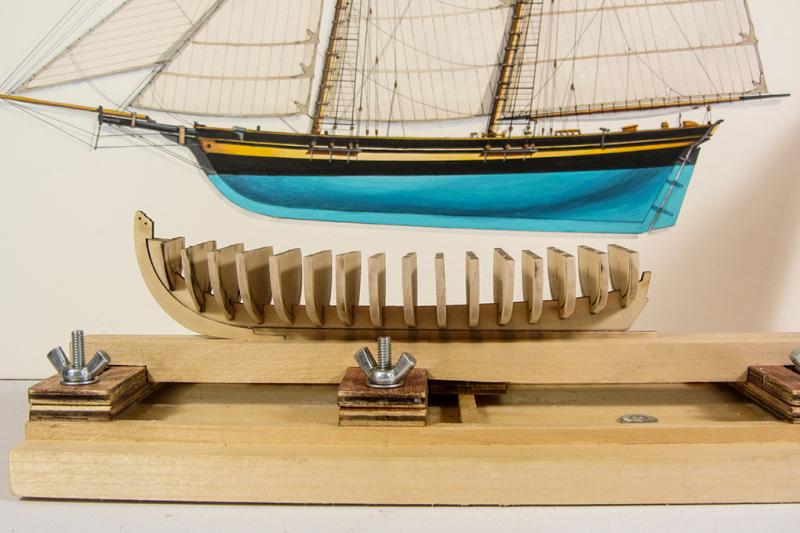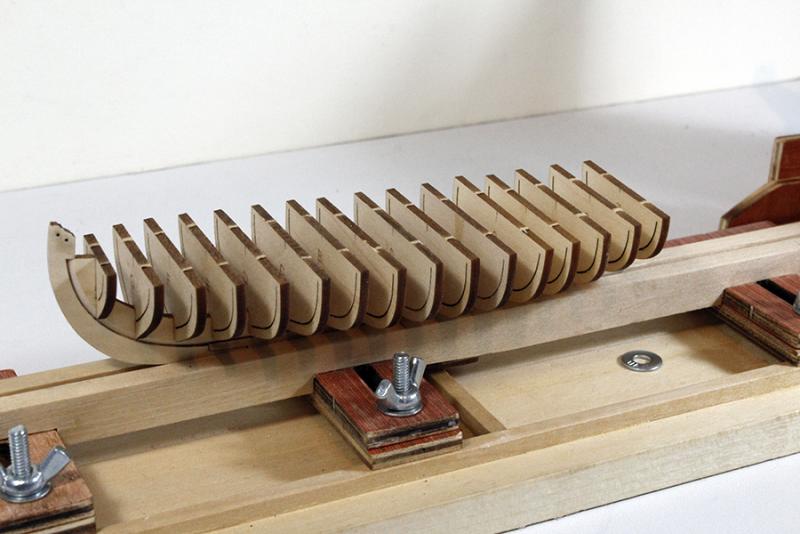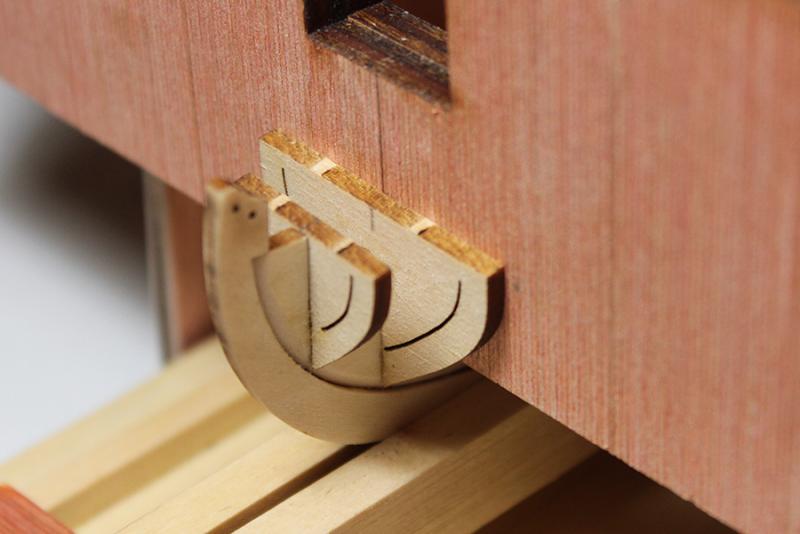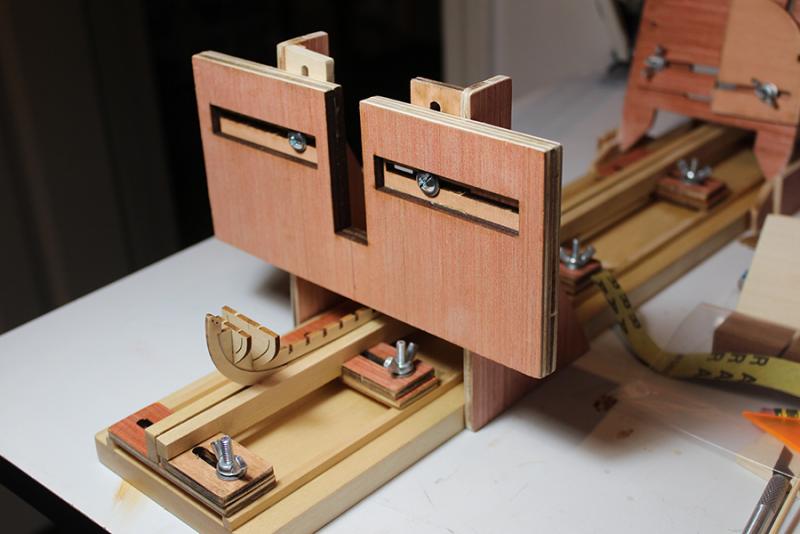-
Posts
841 -
Joined
-
Last visited
Content Type
Profiles
Forums
Gallery
Events
Everything posted by michaelpsutton2
-
I think that there were some transitional ships built in which the middle strake was thicker than the regular plank but not yet as thick as the wales theselves. All three strakes would be paintied black and would give the appearance of a solid wale. At what point were the wales constructed with the anchor stock pattern?
-
So now I think the frames are square and mostly beveled, might need a little more work where the garboard is going to go. So I have questions about planking. 1.) According to the directions, the sheer is actually a little variable so long as it meets the upper edge of the transom aft, and the upper edge of the fairing blocks foreward ? 2.) The first two upper strakes are put on full width. But they need to be bent in two dimensions. for the sheer and also around the ribs. Do you bend them in one direction at a time? The sheer first? And does rewarming them for the second bend undo the first?
-
I really like the look of the pencil in between the planks to accentuate the seams. Will that work in the scarf joint between the stem and the keel or will it interfere with the adhesive? Also how do you feel about a little satin poly on the flat surfaces before assembly. I want all the parts to look separate. Chuck when you talk about reinforcing the stem, do you mean the stem itself or the joint with the keel?
-
So........this is my first build and to kinda bring up my woodworking skills a bit (did I mention I am primarily a researcher, painter, & illustrator) I have spent every evening since Christmas sanding building and varnishing a "Fair-a Frame". I certainly can do the filler blocks and understand how they would work but just have to ask why? I thought the filler blocks were used by guys who didn't hve ready access to a new, softly glowing "Fair-a Frame".
-
Good afternoon, it is so cool to be 64 years old and still be getting toys for Christmas. In this case the Model Expo 18th Century Longboat kit. I did not really intend to take up a lot of time on a build log that has been done a dozen times but still need a little bit of advise from time to time. I just opened the box a couple of hours ago and already I have questions. 1.) There are two identical laser cut keel and two stems, both cut from extremely this stock. There is nothing in the instruction book about this. Should they be glued face to face in order to reach full thickness. The false keel is twice as thick. 2.) What is the best glue for the planking? I am intending to use yellow caprenters for the frame because of the slow set up time. I have a "Fair-a frame" to get them straight. 3.) I have seen some builds where a long piece is glued across the tops of the frame centers to help stiffen them during the fairing/planking process. I this a good idea? Thanks Mike
-

ancre Le Fleuron by juzek - 1:27
michaelpsutton2 replied to juzek's topic in - Build logs for subjects built 1501 - 1750
I have always liked this ship and am looking forward to see how it goes -
You might look at: "Period Ship Modelling: An Illustrated Masterclass" by Phillip Reed. There is a detailled explanation about making sails for his model of the Prince of Neufchatel
-

Introduction of royal yards to the Royal Navy
michaelpsutton2 replied to Mark P's topic in Masting, rigging and sails
You can imagine that the royal yards were introduce gradually. By this I mean early on they were lash up affairs made with spare spars. There was almost certainly a period when they were set "flying" with no braces or clue lines and were taken down poles yards and all instead of being furled. Think about the gunter skysails on the USS Constitution early in the 19th century as compared to the permanent ones on McKay's and Webb's clipper 25 years later. It is a maturing and refining process at work. -
Working on a drawing of the Fife yacht Mariquita. Tons of photos available. So with enough care and patience it should be possible to get each sail seam, reinforcement and gusset in just the right place. But............ No one photo has a perfect view of the complete set of sails. So it takes multiple pictures. You got to make sure the different photos you use were taken at the same time. The sail plans on yachts are always being tweeked. So if you have a sail plan from 2006 and you are trying to put the cloth arrangement from a 2014 photo, it may not work. The 2014 sail may not be the exact same shape as the 2006 plan shows. No reason in the world to go into how I have come by this particular "epiphany"
-
It is hard to tell does the ship in the painting have trailboards. McKay's ships di not have trailboards. That would be more common in British ships.
-
The single topsails say American 1850's clipper. The flag is British. A vessel from 1850-1865 for sure. The painting has something of the "feel" of a Montague Dawson painting.
-

Pennants Flown from Mastheads c1770
michaelpsutton2 replied to BANYAN's topic in Masting, rigging and sails
Over the years I have found "Flags:for Ship Modellers and Marine Artists" by Alec A Purves to be most helpful. Particularly the sections on how to size flags and pennants
About us
Modelshipworld - Advancing Ship Modeling through Research
SSL Secured
Your security is important for us so this Website is SSL-Secured
NRG Mailing Address
Nautical Research Guild
237 South Lincoln Street
Westmont IL, 60559-1917
Model Ship World ® and the MSW logo are Registered Trademarks, and belong to the Nautical Research Guild (United States Patent and Trademark Office: No. 6,929,264 & No. 6,929,274, registered Dec. 20, 2022)
Helpful Links
About the NRG
If you enjoy building ship models that are historically accurate as well as beautiful, then The Nautical Research Guild (NRG) is just right for you.
The Guild is a non-profit educational organization whose mission is to “Advance Ship Modeling Through Research”. We provide support to our members in their efforts to raise the quality of their model ships.
The Nautical Research Guild has published our world-renowned quarterly magazine, The Nautical Research Journal, since 1955. The pages of the Journal are full of articles by accomplished ship modelers who show you how they create those exquisite details on their models, and by maritime historians who show you the correct details to build. The Journal is available in both print and digital editions. Go to the NRG web site (www.thenrg.org) to download a complimentary digital copy of the Journal. The NRG also publishes plan sets, books and compilations of back issues of the Journal and the former Ships in Scale and Model Ship Builder magazines.








